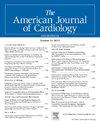多中心跨安纳托利亚注册中心:口侧LAD病变的口侧支架植入或交叉支架置入。
IF 2.1
3区 医学
Q2 CARDIAC & CARDIOVASCULAR SYSTEMS
引用次数: 0
摘要
经皮冠状动脉介入治疗(PCI)孤立的口左前降支(LAD)病变在技术上仍然困难。准确的道口支架植入术(AOS)旨在防止左主干冠状动脉(LMCA)受损伤,而交叉支架植入术(COS)确保完全覆盖道口,但可能增加手术的复杂性。本研究旨在评估接受AOS或COS治疗口腔LAD疾病患者的长期预后。回顾性收集2014年至2025年接受PCI治疗口侧LAD病变的患者。主要终点是主要心脏不良事件(MACE),包括心源性死亡、靶病变血运重建术(TLR)和靶血管心肌梗死(TVMI)。这项大规模多中心(n=12)观察性研究共纳入1167例连续患者[男性:859例(73.6%),平均年龄:61.70±12.73岁],伴有口部LAD病变,接受PCI;其中577例(49.4%)行COS治疗,590例(50.6%)行AOS治疗。MACE发生率(18.1 vs. 9.5%, p本文章由计算机程序翻译,如有差异,请以英文原文为准。
Ostial Stent Implantation or Crossover Stenting for Ostial LAD Lesions: The Multicenter CROSS-ANATOLIA Registry
Percutaneous coronary intervention (PCI) for isolated ostial left anterior descending artery (LAD) lesions remains technically difficult. Accurate ostial stenting (AOS) aims to prevent involvement of the left main coronary artery (LMCA), while crossover stenting (COS) ensures complete ostial coverage but may increase procedural complexity. This study aimed to evaluate the long-term outcomes of patients who underwent AOS or COS for ostial LAD disease. From 2014 to 2025, patients who underwent PCI for ostial LAD lesions were retrospectively collected. The primary outcome was major adverse cardiac events (MACE), including cardiac death, target lesion revascularization (TLR), and target vessel myocardial infarction (TVMI). This large-scale multicenter (n = 12) observational study included a total of 1,167 consecutive patients [men: 859 (73.6%), mean age: 61.70 ± 12.73 years] with ostial LAD lesions who underwent PCI; 590 (50.6%) of the cases were revascularized with AOS, and 577 (49.4%) were treated with COS. The incidences of MACE (18.1 vs 9.5%, p <0.001), TVMI (9.2 vs 4.7%, p = 0.003), and clinically driven TLR (10.7 vs 4.2%, p <0.001) were notably higher in the AOS group compared to the COS group. Treatment (AOS) (HR:2.469, p <0.001), chronic kidney disease (HR:1.832, p = 0.003), reduced LVEF (HR:1.016, p = 0.042), SYNTAX score (HR:1.089, p <0.001), lack of intravascular imaging (HR:1.451, p = 0.049), direct stenting (HR:2.171, p = 0.001), stent length (HR:1.036, p = 0.001) were found to be independent predictors of MACE. In conclusion, this nonrandomized study suggests that COS was associated with better long-term MACE, TVMI, and clinically driven TLR rates compared with AOS in patients with ostial LAD disease.
求助全文
通过发布文献求助,成功后即可免费获取论文全文。
去求助
来源期刊

American Journal of Cardiology
医学-心血管系统
CiteScore
4.00
自引率
3.60%
发文量
698
审稿时长
33 days
期刊介绍:
Published 24 times a year, The American Journal of Cardiology® is an independent journal designed for cardiovascular disease specialists and internists with a subspecialty in cardiology throughout the world. AJC is an independent, scientific, peer-reviewed journal of original articles that focus on the practical, clinical approach to the diagnosis and treatment of cardiovascular disease. AJC has one of the fastest acceptance to publication times in Cardiology. Features report on systemic hypertension, methodology, drugs, pacing, arrhythmia, preventive cardiology, congestive heart failure, valvular heart disease, congenital heart disease, and cardiomyopathy. Also included are editorials, readers'' comments, and symposia.
 求助内容:
求助内容: 应助结果提醒方式:
应助结果提醒方式:


